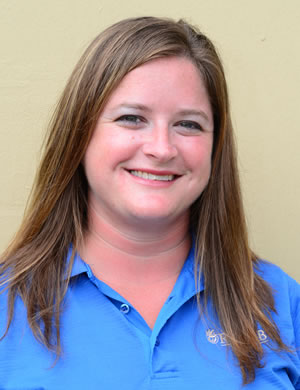Recovery Through Recreation
Kimberly Ulrich
Recreation therapist at Rehabilitation Hospital of the Pacific (REHAB)
Where did you receive your schooling and training?
I have a degree from Indiana University and I started my training in Indiana at Turnstone Center for Disabled Children and Adults.
How long have you been practicing?
I’ve been working in rehab for about 16 years.
Kimberly Ulrich
What are your duties with REHAB?
I ask the patients what they enjoyed doing for recreation in their everyday life before they came to the hospital. Then I try to adapt those activities here at the hospital. We sneak in the therapy under “fun,” where they don’t know it’s happening. If they play golf, I try to do golf activities, or they might like gardening, cooking or painting.
What are the therapeutic benefits of activities such as gardening?
At REHAB we try to plant a flower or vegetable depending on what they normally do in their own home, and then it’s theirs to take care of and take home. It’s a good test of their cognitive skills to remember that they have something besides themselves to take care of. In much the same way as they have to take care of themselves, they have to remember to take care of their plant while they’re here. It’s good practice because once they go home, they sometimes have animals or gardens to take care of.
What are some tips for those who are looking to start gardening after an injury?
We talk about container gardening – getting the very large containers that you can plant one tomato or vegetable plant in, and as long as you keep them watered they do very well. We talk about sitting on a stool or chair, and having a planter where they can sit at the garden and do things from a seated position.
One of the hardest skills to get back after an injury is being able to get up from a floor position. I encourage patients not to go all the way down to the ground if they don’t have to. Taking a chair or a stool out into the garden, makes it a lot easier to get back up.
We are in the middle of remodeling the hospital and we’ve been talking about putting in wheel-chair-accessible gardens and raised garden beds.
Sometimes I give patients materials on dimensions and how they can raise their own garden bed.
For people who enjoy gardening, it is such a part of their lives, getting outside and taking pride in what they have grown. For a lot of people just getting out and having something to do brings such joy. When you take that away, it’s really hard for people. That’s the reason in even small basic ways I try to get them to get back into gardening.
Why is participating in recreational activities important?
A big part of what I do is getting patients involved in the community. We take them out of the hospital and try to get them back into going out and doing things in the community because the hospital is not where they are going to live the rest of their life. You’re going to live out in the community and do things. If I have a person who is interested in gardening, I might take them to the Lili’uokalani Botanical Garden, and through that they get in some recreational activity, and they get therapy.
I find people will go much farther in therapy and do more when they get interested in everything around them. That’s one of the great joys about rec therapy – patients do more than they do in other situations because they’re interested in what is around them and they’re not thinking of it as therapy.
I used to work at a hospital where patients knew certain markers, like if they walked to the end of the hallway, they could sit. You’d get them out in the community and go places with them and the next thing you know they’ve gone much farther than they’ve ever gone in the hospital. You definitely see patients get more motivated when they get out of the hospital for a bit, because they’re getting to do something different from their normal routine.
Is there adaptive equipment available for gardening?
I have our patients work with large-handled instruments. Wider handles make it easier to grip, especially for arthritic hands, especially anything that’s wider around the base. It’s also good if the tool has a non-slip grip. Most gardening centers have them – just look for the largest handle, don’t go the cheap route and get thin handles. Most places even have shorter-handled spades or shovels that you can use from a seated position. It’s nice because instead of spending a lot of money on a specific modified tool, you can get these tools at your everyday home improvement center.







